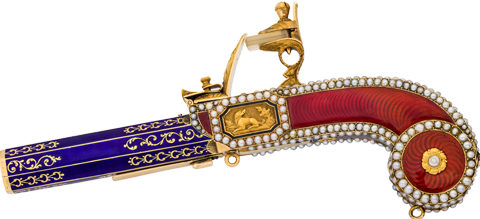THE PISTOL
C. The grips of translucent scarlet enamel over inqué grounds decorated with small gold rosettes on black champlevé enamel with gold owers, the borders set with half pearls. Gold plates, nely chased with a dog on one side and a rabbit on the other, framed with half pearls. The barrels of cobalt blue translucent champlevé enamel over inqué grounds, with a raised gold scroll design simulating damascene work. The perfume is released through the pistils of gold lotus owers with enamelled petls, which are shot out of the barrel. The act of cocking the hammer winds the mechanism, also lowering the trigger. The watch is concealed in the end of the butt, the spring-loaded front and back covers with half pearl-set borders, decorated with inqué rosettes and centeredwith half pearls.
D. White enamel with Arabic numerals, outer minute divisions. Gold “spearhead” hands.
M. 15 mm. ø, gilt brass full plate with cylindrical pillars, fusee and chain, verge escapement, plain three-arm brass balance, continental cock pierced and engraved. In a Chinese tted box with original keys decorated with matching scarlet enamel over inqué engraving and white enamel borders. LENGTH 111 mm.
CHF 350,000 – 550,000 • HKD 2,800,000 – 4,400,000 • USD 350,000 – 550,000
Although not signed, the pistols are almost identical to examples which are signed (F.X. Sturm in “Watches of Fantasy”, plate No. 26, and the matching one from the same pair sold by Antiquorum, Milano, 28 November 1994), enabling us to attribute this one to the same makers : Moulinié, Bautte & Cie.Moulinié, Bautte & Cie. (1772-1837)Jean-François Bautte, born in 1772, became apprenticed at the age of 12, learning the crafts of case-maker, engine-turner, watchmaker, jeweler, and gem-setter. He was barely nineteen years old when he signed his rst watch. In 1797, Bautte took as partner the case-maker Moulinié; in 1804 they were joined by watchmaker Jean Gabriel Moynier, the name of the company becoming rst Moulinié, Bautte & Cie., then Moulinié, Bautte & Moynier. In the early 19th century, Bautte was Geneva’s most importandealer.
The act of cocking the hammer sets up the mechanism, at the same time lowering the trigger. When the trigger is pressed, the hammer descends, and the lotus ower pops out of the barrel, its petals opening and the perfume being sprinkled out!
This object is the twelfth that we have listed to the best of our knowledge (see list and biography). Some others were naturally produced by this workshop at the beginning of the 19th century but the fact remains that this model of montre de fantaisie (watch of fantasy) is one of the most desirable objects of vertu for an art lover, … a connoisseur.
“Objects of vertu” are small objects created from precious materials either to be admired as works of art or, more often, conceived for a practical purpose, especially when there are fitted with watch movements and even more with such a small movement!
